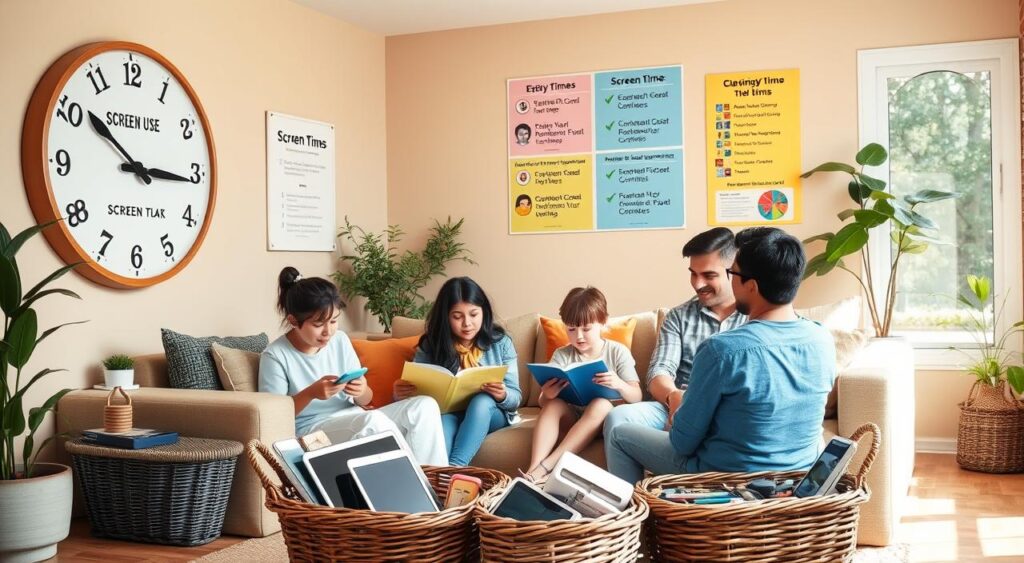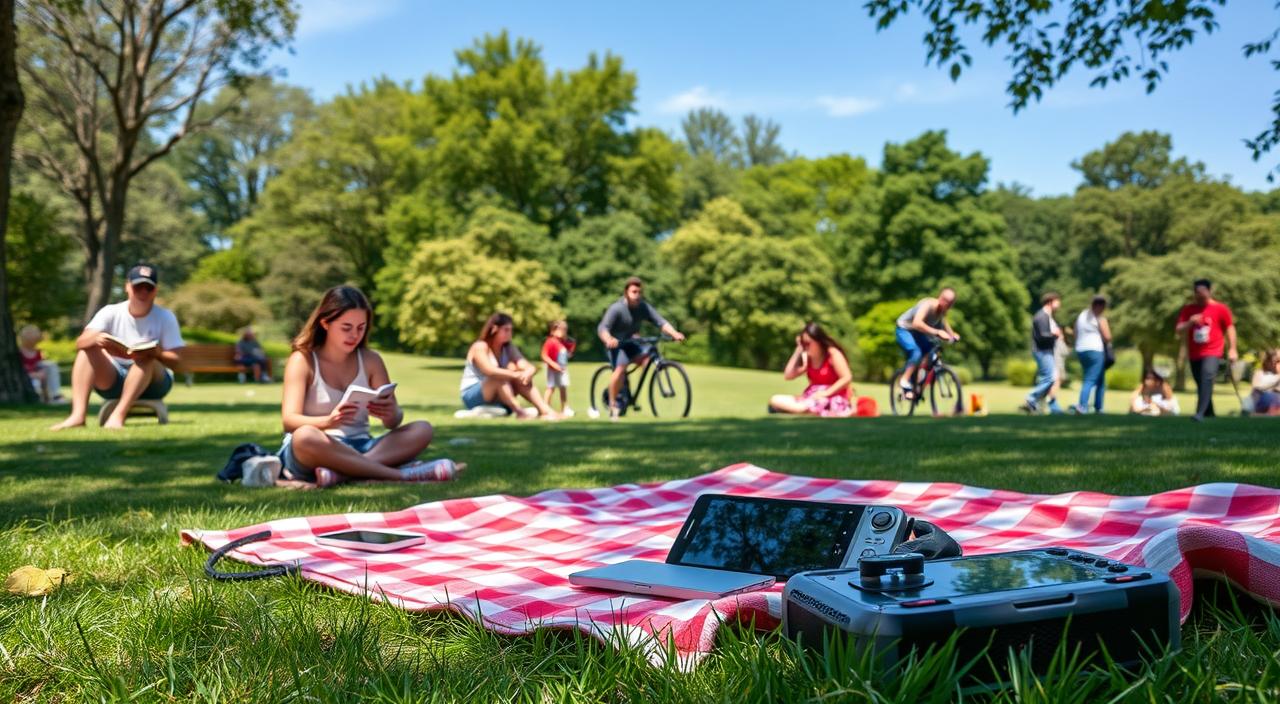Screen Time Reduction Strategies: Many of us spend a lot of time staring at screens. This includes phones, computers, and TVs. In fact, adults in America use screens for over 7 hours a day. This is more than what’s good for our health. Experts say we need to cut down on screen time. They suggest digital detox tips and ways to manage our screen use. This is to keep us healthy and balanced.
Studies show too much screen time can harm us. It can lead to health problems like stroke and heart disease. It can also mess with our sleep and make us feel stressed and anxious. So, reducing screen time is not just about cutting back. It’s about making big changes in our lives. It’s about finding time for activities that don’t involve screens.
Key Takeaways
- ➡️ Adopting screen time reduction strategies are crucial for health, with adults exceeding the healthy limit by a significant margin.
- Taking proactive steps in digital detox can mitigate the adverse health impacts of screen overuse.
- ➡️ Creating boundaries, like screen-free zones and tech timeouts, is effective in managing your digital consumption.
- Including physical activity in your routine is an influential factor in counterbalancing extensive screen time.
- ➡️ Alternative activities and hobbies can redirect attention from screens, enhancing cognitive and emotional well-being.
- Screen-free family interactions, particularly during meals, significantly benefit communication and bonding.
- ➡️ Implementing screen time curfews, especially before bedtime, can lead to better sleep and mental focus.
1. Understanding the Impact of Excessive Screen Time on Health
Digital devices are now a big part of our lives. It’s key to know how screen time affects our health. Too much screen time can harm our bodies and minds.
The Dangers of Prolonged Digital Engagement
Too much screen time can lead to eye problems and discomfort. It also makes us sit too much, causing back and neck pain. How we use our devices can help or hurt our health.
- Less screen time can help with physical issues, which is a big plus.
- Setting limits on kids’ screen time helps them stay healthier by moving more.
Physical and Mental Health Consequences
Screens can also affect our mental health. Too much screen time before bed can mess up our sleep. Being on social media too much can make us feel lonely and anxious.
- Less screen time helps our mental health by letting us interact more and feel better about ourselves.
- Experts say no more than an hour of screens before bed helps us sleep better. This shows we need to set screen-free times.
Children are especially affected by too much screen time. It can hurt their language skills, thinking, and school work. Setting limits and making screen-free areas can help a lot.
| Screen Time Effect | Health Consequence | Recommendation |
|---|---|---|
| 1+ hour before bedtime | Poor sleep quality | No screens one hour before bed |
| Increased social media interaction | Higher anxiety and isolation | Monitor and limit social media use |
| Unrestricted screen access | Poor academic performance | Enforce limits, encourage unstructured play |
Parents and caregivers play a big role in teaching healthy screen habits. By setting good examples and updating rules, families can enjoy digital media safely.
2. Establishing a Baseline: Assessing Your Screen Time Habits
Before you can start reducing screen time, you need to know how much you use screens now. A good screen time assessment helps you see when and how you use devices. This first step is key to a healthier digital life.
Many devices have built-in screen time tracking features. These let you see how much time you spend on apps. You can spot trends and patterns to change. For more detailed info, third-party apps offer tools to help with screen time awareness.
To see how your habits compare, look at typical behaviors. Here’s a quick overview based on recent studies:
| Study | Effectiveness | Sample Size | Duration |
|---|---|---|---|
| Mendoza et al. (2016) | Decrease in TV viewing | Smaller groups | Less than a year |
| Smith et al. (2017) | Reduction via App | Varied | N/A |
| Bandeira et al. (2019) | No significant change | 1085 | N/A |
Interventions can have different results, depending on the tools and methods. Choose strategies that have worked well before. Think about these studies when doing your screen time assessment. Set realistic goals to cut down on screen time.
Use techniques like setting goals and getting feedback to help you succeed. Changing your screen habits starts with monitoring and adjusting your tech use daily. Regular screen time tracking and increased screen time awareness lead to healthier tech use.
3. Creating a Digital Detox Plan
Starting a digital detox plan can free up your time and improve your health. The first step is to set realistic goals for screen time. This helps you gradually reduce your screen use.
Setting Realistic Goals for Minimizing Screen Time
First, figure out how much time you spend on screens. Then, pick small goals, like cutting down by 30 minutes a day. As you get used to it, you can set even bigger goals.
Implementing a Step-by-Step Approach to Digital Detox Tips
Creating a step-by-step plan makes it easier to reduce screen time. Tell your friends or family about your detox. This way, you’ll have their support and it will be more fun. Replace screen time before bed with relaxing activities like reading or meditation. Make sure some areas of your home are tech-free. This helps you avoid distractions and build better habits.
Here are some activities for your digital detox plan:
- Offline Activities: Try hobbies like gardening, knitting, or playing music without a screen.
- Real-Life Connections: Spend time with friends and family to boost your social life.
- Mindfulness Practices: Take time for self-reflection, deep breathing, or a short walk to reduce stress.
Reducing screen time improves your health and boosts productivity. It takes commitment but is very rewarding. You’ll feel more fulfilled in your personal and professional life.

4. Setting Clear Boundaries for Technology Use
Understanding the need to limit screen time at home is key. Creating screen-free zones helps your family stay healthy. It encourages more fun and creative activities.
Designing Screen-Free Zones at Home
Creating screen-free zones changes how your family connects. Pick places like dining rooms or bedrooms where screens are banned. This makes time for meals, talks, and fun together.
Employing Technology to Limit Technological Exposure
Using technology for screen time management is smart. Apps and settings help track and limit screen time. They enforce downtime and block notifications when needed.
| Age Group | Strategy | Outcome |
|---|---|---|
| Under 2 years old | No screen time, except video calls | Enhanced real-life interaction |
| Children | Set specific times for screen use | Predictability reduces screen demands |
| Teens | Compromise on rules, reevaluate after trial | Adaptable rules foster responsibility |
Structured screen time plans, like limiting screen time at home or screen-free zones, are key. They help create a balanced digital space. Using technology for screen time management ensures these rules support growth and family bonds.
5. The Role of Physical Activity in Reducing Screen Time
Getting involved in physical activities to reduce screen time is key to managing screen use and boosting health. Studies show a rise in sitting time, especially among teens. Adding movement to your day helps break the screen’s hold and cuts down on screen time.
Recent studies highlight the importance of physical activity, especially for teens. A study in Gran Canaria, Spain, found big differences in activity levels. Girls were less active, and boys who spent more time on screens were at higher risk of not meeting activity goals.
Think about the active lifestyle benefits that can fight against too much screen time. Being active not only cuts down on sitting but also boosts overall health. It helps prevent diseases like type 2 diabetes and high blood pressure.
| Activity Type | Time Reduction in Screen Use | Health Benefits |
|---|---|---|
| Moderate Physical Activity | 26.4 min/day | Improved cardiovascular health |
| Vigorous Physical Activity | 130.2 min/day | Weight management, enhanced muscle and bone strength |
| Recreational Sports | Varies | Social skills improvement, reduced depression risk |
Adding daily routines with physical activities to reduce screen time helps lead an active life. It also changes how you use digital devices. Following the American Academy of Pediatrics‘ guidelines for screen time can lead to a healthier, more fulfilling life. Using structured physical activities not only reduces screen time but also enriches your life. So, why not swap some screen time for something active today?
6. Embracing Alternative Leisure Activities Beyond the Screen
In today’s world, it’s key to value real-life talks and hobbies that don’t need screens. Spending time on other activities can make life richer and better for your mind and heart.
Rediscovering Hobbies that Don’t Involve Digital Devices
Try hobbies like painting, playing music, or crafting to cut down screen time. These hobbies boost creativity and can calm your mind. They also help you learn new things and find new interests.
The Value of Face-to-Face Interactions
Face-to-face talks are priceless. They help us form deeper, more meaningful bonds. These talks are vital for our emotional and social growth, making us happier and healthier.
To show why it’s good to cut down screen time, let’s look at the effects of too much screen use:
| Age Group | Average Screen Time Daily | Recommended Screen Time | Effects of Excess Screen Time |
|---|---|---|---|
| 2-5 years | 2+ hours | 1-2 hours | Language delays, behavioral problems |
| 6-10 years | 6 hours | 2 hours | Risk of obesity, attention problems |
| 11-14 years | 9 hours | 2 hours | Depression, anxiety, academic issues |
These numbers should make us think about how to balance digital time with real-life moments. Whether it’s starting a new hobby or spending more time with family, every step counts towards a better life.
7. Techniques to Reduce Screen Time Through Mindfulness and Self-regulation
Reducing screen time is key for our health in today’s digital world. Using mindfulness practices and self-regulation tips can help a lot. They are great for managing screen cravings.
Practicing Mindfulness to Curb Screen Urge
Mindfulness is more than just a trend; it’s a powerful tool. It helps you notice your actions and choices. When you want to use your phone or computer, pause and breathe. Focus on your breath and its journey. Ask yourself if screen time is really needed. These moments build mindfulness, leading to better choices about screen use. Mindful breaks between digital and non-digital activities also work well. They help cut down on screen time.
Using Self-regulation Strategies to Resist Screen Temptation
Setting screen time limits is a self-regulation tip. For example, limiting social media to 20 minutes can cut down screen time a lot. Apps that track and remind you of your screen time can also help. Creating tech-free zones or specific screen time hours is also effective. It helps many reduce unnecessary screen use. This leads to healthier tech use.
Studies show these methods work. In programs like EmpowerU, 92% of students cut down their screen time. 90% reported better focus, and 85% felt less anxious. These programs use mindfulness and self-regulation to achieve great results.
By adding mindfulness and self-regulation to your life, you can control screen time better. This improves your mental health and productivity. These practices not only improve your life but also your relationships, leading to a more balanced digital life.
8. Incorporating Screen Time Management into Family Routines
Managing screen time is key for a balanced life, especially for kids. Adding family screen time management to your daily life sets healthy limits. It also makes family time more engaging and free from digital distractions.
First, figure out how much time your family spends on screens. Kids in the U.S. spend over seven hours a day on devices. The American Academy of Pediatrics suggests just one hour a day for kids aged 2 to 12, and two hours for teens and adults. Following these guidelines can greatly reduce health risks.
Setting routine-based screen time control improves time management and family bonds.
Try setting screen-free times, like no screens during meals. This boosts family talk and strengthens bonds. It’s part of a bigger plan to focus on physical activities or outdoor play.

Use educational content during allowed screen time. PBS Kids, Sesame Street, and National Geographic Kids are great options. Tools like Mobicip help manage screen time, ensuring kids watch educational content.
- Use Mobicip’s Screen Time Scheduler for homework, sleep, and fun screen times.
- Choose age-appropriate media with MediaSmarts and Common Sense Media to enhance learning.
- Teach kids about online safety with NetSmartz workshops.
Adding these steps to your routine balances screen time. It limits too much use and encourages tech for learning and productivity.
Thoughtful screen time management makes tech a tool for growth, not a barrier to family health.
9. Striving for a Healthier Work-Life Balance in the Digital Age
The digital age brings new challenges to work-life balance. Managing screen time is key, especially for remote workers. It’s about discipline and finding ways to be more productive.
Creating a balance between work and personal life is crucial. When your office is close to your home, it’s easy to get caught up in work. Here are some tips to help you find a better balance.
Screen Time Management in Remote Work
Remote work means more screen time, which can lead to burnout. Setting a schedule and taking breaks can help. Use tools to block distracting websites and take breaks. It’s not just about cutting down on screen time. It’s about using your time wisely to stay productive and healthy.
Maximizing Productivity While Cutting Back on Screen Time
Being productive means working smarter, not harder. Focus on your tasks without distractions. Try digital detox to reduce constant screen use. Start with small steps, like a 30-minute screen-free time before bed or in the morning. Set aside tech-free hours during the day. Enjoy activities that don’t involve screens, like outdoor play or journaling.
By managing your screen time, you can create a work environment that values your personal time. This ensures you stay productive without sacrificing your well-being.
FAQs (Frequently Asked Ques)
What are some strategies for reducing screen time?
To cut down on screen time, start by making some areas screen-free. Set goals that feel achievable. Plan a digital detox and add physical activities to your day.
Use mindfulness and set limits on your screen use. This can help you stay in control of your screen time.
To cut down on screen time, start by making some areas screen-free. Set goals that feel achievable. Plan a digital detox and add physical activities to your day.
Use mindfulness and set limits on your screen use. This can help you stay in control of your screen time.
How can excessive screen time affect my health?
Too much screen time can harm your health. It can cause eye strain and vision problems. It may also lead to neck and back pain.
It can even cause injuries in your hands and wrists. Screen time can disrupt your sleep and lead to obesity. It can also affect your mental health, causing feelings of loneliness and low self-esteem.
Too much screen time can harm your health. It can cause eye strain and vision problems. It may also lead to neck and back pain.
It can even cause injuries in your hands and wrists. Screen time can disrupt your sleep and lead to obesity. It can also affect your mental health, causing feelings of loneliness and low self-esteem.
How can I track and manage my current screen time habits?
Use apps or built-in features on your devices to track your screen time. This lets you see which apps you use the most. Then, you can set limits to control your screen use better.
Use apps or built-in features on your devices to track your screen time. This lets you see which apps you use the most. Then, you can set limits to control your screen use better.
What are some digital detox tips to help minimize screen time?
Begin by setting realistic goals for reducing your screen time. Take it slow and share your goals with friends or family for support. Find new activities like reading or meditation to replace screen time, especially before bed.
Begin by setting realistic goals for reducing your screen time. Take it slow and share your goals with friends or family for support. Find new activities like reading or meditation to replace screen time, especially before bed.
How can I create screen-free zones at home?
Choose areas in your home, like bedrooms or dining rooms, to be screen-free. Make sure everyone in your family respects these zones. This helps promote healthier habits and better interactions.
Choose areas in your home, like bedrooms or dining rooms, to be screen-free. Make sure everyone in your family respects these zones. This helps promote healthier habits and better interactions.
Can technology help me in reducing my screen time?
Yes, technology can help you reduce screen time. There are apps that lock your phone for a while, track your screen time, and block distracting sites or apps. Use settings like ‘Do Not Disturb’ to reduce distractions and notifications.
Yes, technology can help you reduce screen time. There are apps that lock your phone for a while, track your screen time, and block distracting sites or apps. Use settings like ‘Do Not Disturb’ to reduce distractions and notifications.
What is the importance of physical activity in cutting back on screen time?
Physical activity distracts you from screens and helps counteract the sedentary effects of screen use. It boosts your energy and improves your health. It also lowers the risk of chronic health problems linked to a sedentary lifestyle, encouraging less digital device use.
Physical activity distracts you from screens and helps counteract the sedentary effects of screen use. It boosts your energy and improves your health. It also lowers the risk of chronic health problems linked to a sedentary lifestyle, encouraging less digital device use.
How can I replace screen time with engaging in hobbies and real-life interactions?
Invest in hobbies that don’t need screens, like painting, cooking, or gardening. Prioritize face-to-face social activities over online ones. This strengthens relationships and offers a fulfilling experience away from digital screens.
Invest in hobbies that don’t need screens, like painting, cooking, or gardening. Prioritize face-to-face social activities over online ones. This strengthens relationships and offers a fulfilling experience away from digital screens.
How can mindfulness and self-regulation help in managing my screen cravings?
Mindfulness, like meditation, makes you more aware of your screen use and why you’re using it. Self-regulation strategies, like setting time limits and choosing not to check your phone often, help you resist excessive screen use.
Mindfulness, like meditation, makes you more aware of your screen use and why you’re using it. Self-regulation strategies, like setting time limits and choosing not to check your phone often, help you resist excessive screen use.
How do I incorporate screen time management into my family’s routine?
Set family rules for screen use, like no devices at meals. Plan activities that don’t involve screens. Consistent rules and ‘lean times’ encourage kids to be active and limit screen time, making it a part of your family’s daily routine.
Set family rules for screen use, like no devices at meals. Plan activities that don’t involve screens. Consistent rules and ‘lean times’ encourage kids to be active and limit screen time, making it a part of your family’s daily routine.
What are some ways to manage screen time while working remotely?
To manage screen time while working from home, create a structured schedule with regular breaks. Focus on tasks without unnecessary screen distractions. Disconnect from work after hours to keep a healthy work-life balance.
To manage screen time while working from home, create a structured schedule with regular breaks. Focus on tasks without unnecessary screen distractions. Disconnect from work after hours to keep a healthy work-life balance.
How does reducing screen time promote productivity?
Reducing screen time minimizes distractions, allowing for more focused work. Cutting back on digital activities frees up time for other productive tasks. It also prevents mental fatigue from constant screen use, boosting overall productivity.
Reducing screen time minimizes distractions, allowing for more focused work. Cutting back on digital activities frees up time for other productive tasks. It also prevents mental fatigue from constant screen use, boosting overall productivity.








[…] this guide, we’ll share expert tips to reduce social media anxiety. We’ll talk about setting boundaries and being mindful online. Whether you want to […]